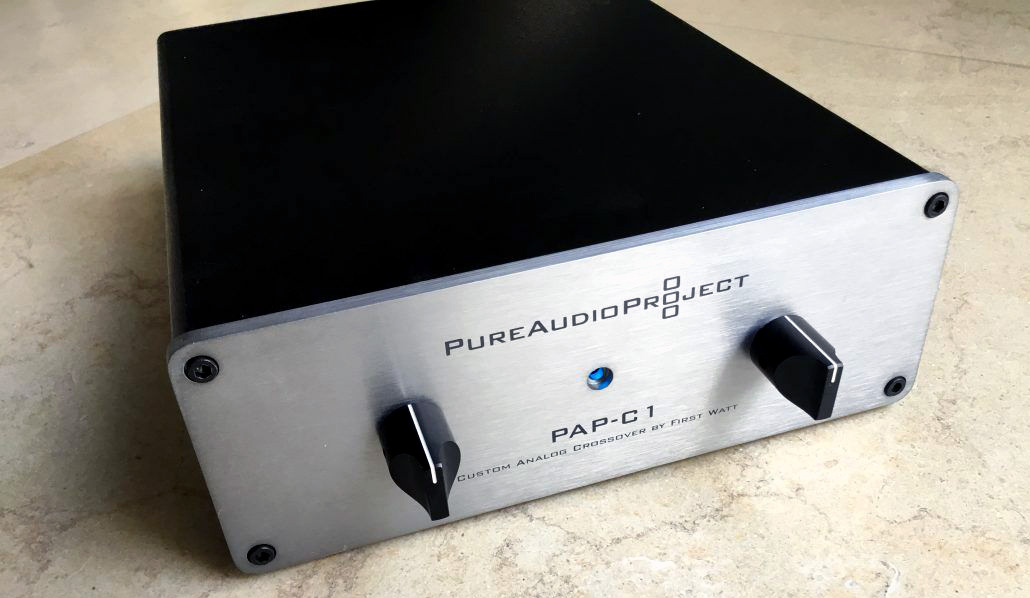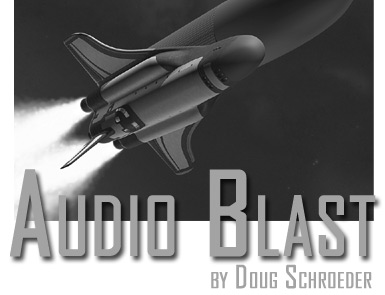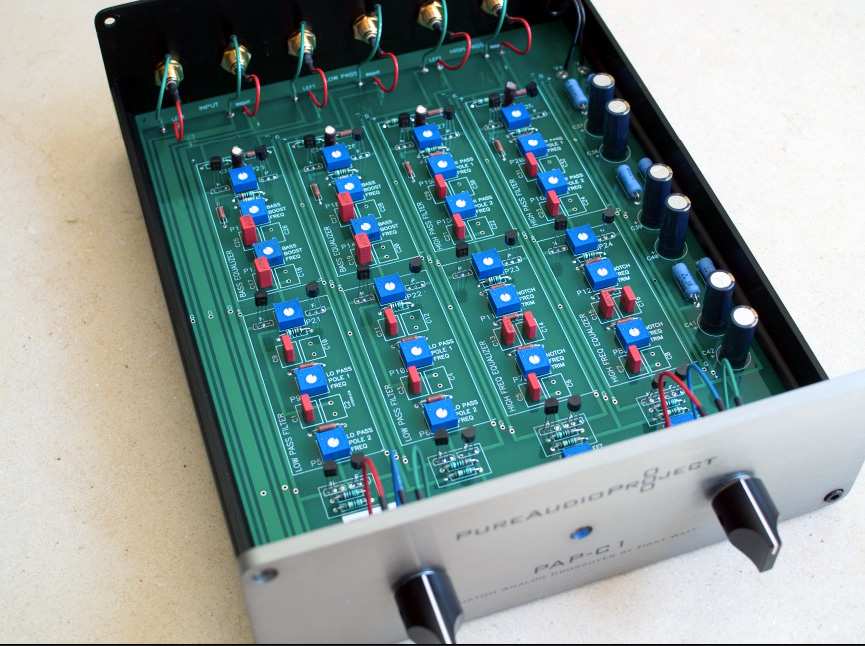
Could your audiophile life use a little spicing up? Care to go where no lazy audiophile has gone? Want some mid-Winter fun? How about a speaker system that caters to adventure with an adjustable active crossover? In this article I focus on my first month with the PureAudioProject PAP-C1 Active Crossover. I will share how I delved into the use of this crossover, and cover most of the pertinent aspects of ownership. No, it is not a long-term look at the unit, but the basis for my recommendation rests on the fundamental operation and outcome of using it in comparison to the typical passive crossovers for the Trio15 line, and that conclusion I do not believe will revert over time.
Having favorably reviewed three iterations of the PureAudioProject Trio15 speaker (Tang Band and Voxativ, both using full range primary drivers, and the Horn 1), I have some firm conclusions about the design. I like it quite a bit, and feel the customer gets a big helping of good sound from this self-assembled speaker company’s products. PureAudioProject (PAP) is now putting out cosmetically finished versions that have more curb appeal. I have enduring pleasure in using the Trio15 PAP-Horn1, the best of the three setups in my experience. The Voxativ is as beguiling in some respects, but as I have less experience in using horn speakers the novelty of the design has caused some favoritism recently. That may need to be taken into consideration when selecting the model one wishes. All three present valid options depending upon the customer’s wishes.
This article is about an intensive, no-nonsense system building assault with the PAP-C1. It focuses on two iterations of systems representative of the work and results that come from using this crossover. While the amount of system configuration is lower than my typical article, the application of methods and efficacy of the PAP-C1 is very wide, and prospective owners should expect similar capabilities, as well as surprising performance potential.
Convergence
There are times in reviewing when separate reviews converge, and the beneficial pairing of certain products produces an unexpectedly powerful result, one that begs for the unrelated product(s) to be recommended as a unit. I have been spending much time lately reviewing Open Baffle speaker designs, with not only the PureAudioProject review but also a close look at some of the Tri-Art audio Series B components and the Series B 5 open speaker (Tri-Art doesn’t seem to capitalize the names of their products on the website or owner’s manuals, so I am following suit). Especially in terms of the Tri-Art passive preamplifier, with its unusual settings for gain related to its tube operation, as well as the accompanying Series B tube buffer power supply, some dramatic swings can be put into place with not only the 5 open speaker, but also the Trio15 Horn1 in conjunction with the PAP-C1 Active Analog Crossover. Much of this article was developed as the Tri-Art preamplifier and power supply were inserted into the review system, and I make much of that combo’s use in association with the PAP-C1. I will present a thorough workup of the Tri-Art products in their own review. For now, the curious reader who glances at the 5 open will note the user-adjustable attenuator on the speaker’s external crossover, which may not seem so special. However, when paired with the Tri-Art Series B preamplifier and amplifier, each offering an optional tube buffered power supply, setup options multiply.
Together, both of these speakers, the 5 open and the Trio15-Horn1, with their own special sauce of contouring controls, are impressing upon me the remarkably capable and affordable genre of Open Baffle speakers (these employ dynamic drivers, not magnetic planar or electrostatic). While I have spent plenty of time with magnetic planar and electrostatic speakers, this is the most involved I have been with Open Baffle designs. I am attempting to make up for lost time!
To the point of this article, my interest in use of an active crossover to manipulate a speaker’s driver set(s) was first experienced in a rather involved series of articles about the Legacy Audio Whisper, especially the “DSW” version. For those interested in going deep on all this, see my articles at Dagogo about the Whisper and its different iterations. After a handling a few more speakers with passive crossovers, the next one with an adjustable outboard crossover was considerably more minimal than the Trio15 Horn1, the Tri-Art audio Series B 5 open speaker, currently under review. The only user-adjustable control for the speaker (aside from changing out jumper wires from crossover to speaker) is an attenuator for the full range driver. But that is enough to engender much zeal for this hybrid design!
The success I was experiencing with the 5 open brought to my mind the PAP-C1 active crossover. At one point I had a PAP-C1 in my home, but was so harried by personal schedule and reviews that I elected to return it. Hearing an open baffle design with contouring capability caused me to reconsider. If a single attenuator could do so much, what might happen if a more fully realized active crossover was used? This article summarizes my investigation into that question.
More complexity for better results
There is a bit of a strange relationship between simplicity and sound quality. Typically, the goal of high-end audio is to reduce the manipulation of the signal as much as possible, to simplify the signal path. I often find that more streamlined systems have better definition. But, when a different technology is employed, the calculus of performance can change. Though they make a system more complex, active crossovers can produce superior results, but it must be remembered that this is partly dependent upon the quality of the rest of the components, including cables. If adding an active crossover did as much damage as inserting a graphic equalizer did years ago, I would have little to do with it, but in fact the active x-over can be a most effective way to advance a speaker system.
The written introduction for the PAP-C1 states that it is, “… for Open Baffle and bi-amping fans.” The crossover is designed specifically for this speaker, and it requires bi-amping (four separate channels for discrete signals, two for the Left speaker and two for the Right) for the pair of 15” bass drivers, and full range driver. When it is set up and working it is glorious, but getting there can be a bit gruesome. Well, gruesome is a bit strong, but tedious might apply. The prospective owner of this crossover best be comfortable with some discomfort in operation of the system. He or she also needs willingness to be a student of basic crossover operation and the speaker crossover/driver interface. It is not necessary to have a degree in electronics, or even deep familiarity with operations of electronics in general. It helps to have some familiarity with graphs and what the terms high pass,low pass,and filter mean. The prospective owner must not be afraid to put hands into the component and fiddle with it by adjusting settings. If you are not squeamish about such things and have an insatiable curiosity for refinement in sound, then the PAP C-1 may be a joy ride!
The owner of the PAP-C1 will also by necessity need to be comfortable with setting up a significantly more complex audio system —think in terms of double the connections from the source to the speakers. This would not be on the level of a multi-channel HT setup, but perhaps splitting the difference between that and a traditional stereo. Moving from the passive crossover version to the active crossover means more cost in cables, however, it is money well spent. Performance parameters of the PAP-C1 are such that in most conceivable cases the funds invested in the additional cables will return ample performance gains such that this should not be seen as a negative. Patience is a virtue with this device, as hasty and impatient persons will not have the willpower to finesse this finely tuned active crossover to elicit all the beauty it manages. If you are put off by any of these criteria, then consider whether you have a good friend who will shoulder the burden of initial setup for you, or stick with the stock passive crossovers, which can offer commendable flexibility in their own right if the owner wishes to explore options.
One of the forthright conclusions of this review is that passive crossovers are quite restrictive in terms of system integration compared to the myriad and monumental (and I do mean monumental) changes afforded by active crossovers such as the PAP-C1, all of which add up to more potential to nestle the sound right up to the listener’s expectations. In other words, you can manipulate this crossover exponentially more than the stock bi-wire/bi-amp PureAudioProject crossover. If a bit of work, self-educating, time invested and painstaking attention to detail in dialing in a rig is acceptable, then the PAP-C1 is solidly the choice to seek a perfected performance.
- (Page 1 of 3)
- Next page →




What a great review. A good active preamp could improve the system still more.
Vladimir,
God’s Peace,
Thank you for the complement. No doubt the addition of an active preamp could add another level of excitement to the experience. I will not argue about that. Much would depend upon the selection of amplifier and preamp. One thing I love about the Tri-Art Preamplifier is that it is configurable in terms of the “Gain” switches on the Preamp and the Linear Power Supply used with it. The multiple settings on both allow a wide variety of voices for the system, a compelling feature of the passive Tri-Art Preamplifier that would not typically be found with most active preamps. Something to consider. It is possible that an active preamp could improve the system; one simply has to compare to find out.
Blessings,
Douglas Schroeder
I recently upgraded my Spatial Audio OB speakers crossovers to some Jupiter caps and can say that it seems that cheaper crossover parts while keeping costs down, don’t reveal what a speaker or system can really do. I’m surprised there aren’t more outboard crossovers (with upgradable price options) available. Sounds like the PAP is a great device for those interested in maximizing sound quality. Of course I use the Schroeder Method to great success and recommend such, thank you!
ric,
God’s Peace,
One of the great things about the PAP speakers is the upgrade path, which can be done simply with one screwdriver! I found that changing the resistors and capacitors were both efficacious, as discussed in my previous articles. I am not surprised at all at your success.
As you speculate, the PAP C-1 is great for those wishing to push the boundaries further than a passive crossover, albeit with more mild effort.
Thank you for the plug for the Schroeder Method of Interconnect Placement. It’s a wonderful means of elevating an audio system! I use it without exception in my personal systems.
Blessings,
Douglas Schroeder